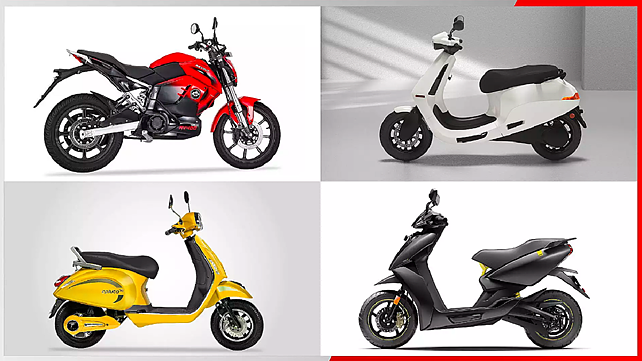
The electric vehicle (EV) industry registered sales of 1,152,021 units, which include E-Buses, E-Cars, E-Three-wheelers, and E-two-wheelers in FY23.
As per the data released by the Society of Manufacturers of Electric Vehicles (SMEV), 120,000 low-speed (LS) E-scooters, 285,443 (LS) E rickshaws, and around 50,000 (LS) E-cycles were also sold in FY23.
EV Adoption Target Declines
In the electric two-wheeler segment, the industry sold 726,976 high-speed E2W (speed>25kmphr) in FY23. However, the E2W adoption fell month-on-month over the targets ending with an annual shortfall of more than 25% over the minimum target set by Niti Aayog and various research organisations.
While the market has been making good progress in recent years towards a sustainable and greener future, industry experts and stakeholders are concerned that the momentum in E2W adoption fell after the Indian festive season.
Ironically, it was not the consumer demand but the sudden withholding of more than the INR 1,200 crore subsidy already passed on by most OEMs to the customers on the pretext of delay in the localisation. Another INR 400 crore of the OEMs operating in the premium end also got stuck due to the allegation of under-invoicing to bypass the FAME norms leading to the crippling of their business operations due to an extreme shortage of working capital.
Today 16 companies representing more than 95% of the industry are waiting for some resolution to the chaos, and the fiasco of the FAME PMP is cleared to enable them to plan their businesses in the year FY24.
Commenting on the performance of the E2W industry, Sohinder Gill, DG SMEV, said, “Over the years, the E2W industry has been catching pace and working relentlessly towards achieving the country’s mission of largely converting to electric. While all the earlier schemes since 2015 had a negligible effect on EV adoption, the revised FAME2 in late 2022 had a dramatic effect on E2W adoption as it decreased their prices by around 35%. This started attracting the component supply chain that had earlier shunned anything to do with E2WS because of extremely low volumes and it is only in late 2021, suppliers started queuing up to OEMS to show their eagerness of developing EV components. It took most of these suppliers 12 to 18 months, the usual time that it takes to localise and now most of them have started setting up sufficient capacities.”
Gill added that some persons with malicious intent unleashed a campaign to put an immediate stop to this dream run for the reasons best known to them. These persons must be rejoicing in the complete derailment of the EV mission of India by forcing the policymakers to take a “black or white” position on the policy rather than a pragmatic approach of flexibility in the implementation due to factors beyond the control of the OEMs. With only 5% adoption in FY23, the short-term goal of 30%, and the EV mission of 80% adoption by 2030 looks more like a mirage. All is not lost, and what perhaps can put the industry back on track is an extension of the PMP eligibility criteria by two years and strictly enforcing it from April 23.
Problem Areas
The absence of enough local manufacturing capacity for vital components like batteries and motors is one of the major problems in the supply chain. Due to supply chain interruptions during COVID, the industry suffered greatly in finding high-quality components.
To develop a sustainable and effective supply chain, numerous ecosystem stakeholders have played a significant role. SMEV noted that the sector has reduced its dependency on imports and is now self-sufficient, with the majority of the components being produced domestically.
The Government’s decision on the continuation of FAME is a critical piece that will decide the fate of the entire industry, and the market is eagerly waiting for clarity. Unfortunately, the confusion among players is making it difficult for them to develop a long-term strategy.
Any abrupt reduction in subsidies will significantly influence the growth trajectory and could jeopardise the Government's plan for e-mobility. It will have a negative effect and could eliminate a sizable portion of the market. To encourage the development of the EV ecosystem and make it self-sustaining, it is crucial to have an extension of the FAME scheme for at least 3–4 years, the apex body noted.
SMEV acknowledges that subsidies can’t be a sustainable solution in the long run; therefore, it recommends phased tapering off of subsidies after reaching a certain threshold.
Currently, the manufacturers pass the subsidy to the customer and claim it from the Government post the sale. The current method lacks transparency, which may lead to OEMs manipulating sales to claim the subsidy fraudulently. SMEV recommends the introduction of a direct subsidy mechanism that allows incentives to be directly paid to the customer by the Government, thus, avoiding any discrepancy.
SMEV welcomes the amendment to the PLI scheme for automobiles and components, which previously restricted MSMEs and startups from participating in the scheme. It will create a level playing field for pure-play EV companies and allow them to compete with other players.
Also Read
With Hero Ruling 100 cc Pie, Honda Has Its Work Cut Out
Ola Electric Leads E2W Sales In 2022, TVS, Ampere Catching Up